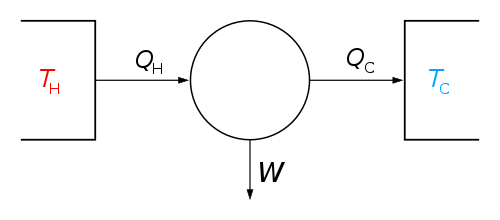Regenerative cooling
Regenerative cooling is a method of cooling gases in which compressed gas is cooled by allowing it to expand and thereby take heat from the surroundings. The cooled expanded gas then passes through a heat exchanger where it cools the incoming compressed gas.[1]
| Thermodynamics | ||||||||||||
|---|---|---|---|---|---|---|---|---|---|---|---|---|
 The classical Carnot heat engine | ||||||||||||
|
||||||||||||
| ||||||||||||
Regenerative cycles
History
In 1857, Siemens introduced the regenerative cooling concept with the Siemens cycle.[2] In 1895, William Hampson in England[3] and Carl von Linde in Germany[4] independently developed and patented the Hampson–Linde cycle to liquefy air using the Joule–Thomson expansion process and regenerative cooling.[5] On 10 May 1898, James Dewar used regenerative cooling to become the first to statically liquefy hydrogen.
gollark: yes, yes, US bad.
gollark: > bruh this entire server is communist and you will be converted <@189831165727866881> (/s)Initiating orbital mind control lasers.
gollark: That is also one of the ones I dislike.
gollark: I mean, I dislike communist/socialist/etc ideologies (hence ☭ bad) for various reasons, but I can... mostly interact with people who hold them without despising them?
gollark: Because some do support that, muahahahaha.
See also
References
- Cryogenic microcooling Pag.25
- Charles William Siemens, "Improvements in refrigerating and producing ice, and in apparatus or machinery for that purpose", British patent no. 2064 (filed: July 29, 1857).
- W. Hampson, "Improvements relating to the progressive refrigerating of gases", British patent 10,165 (filed: May 23, 1895).
- Linde, Carl, "Verfahren zur Verflüssigung atmosphärischer Luft oder anderer Gase" (Method for the liquefication of atmospheric air or other gases), German patent 88,824 (filed: June 5, 1895).
- Hydrogen through the Nineteenth Century
This article is issued from Wikipedia. The text is licensed under Creative Commons - Attribution - Sharealike. Additional terms may apply for the media files.